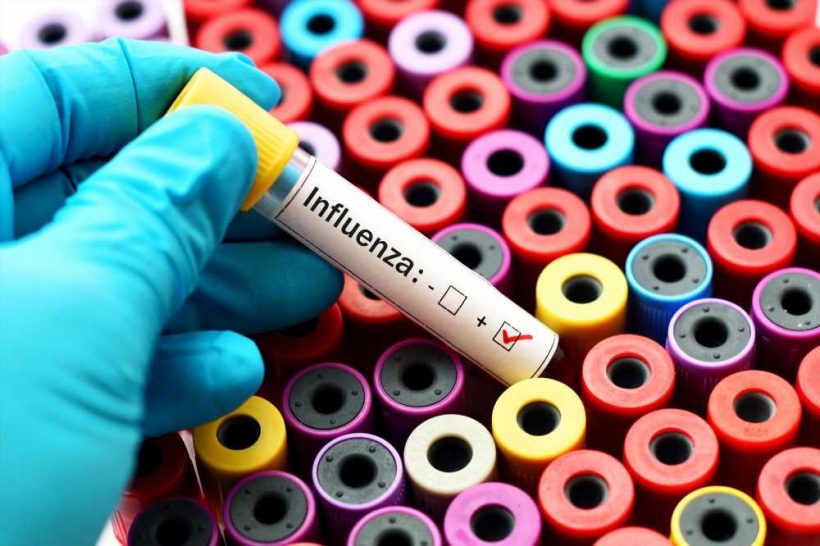
New insights into why obesity puts individuals at risk for severe influenza
In a recent study published in the journal Nature Communications, researchers used blood and airway sampling of morbidly obese individuals and murine models to elucidate the mechanisms underpinning severe cases of influenza among the obese population.
 Study: Obesity dysregulates the pulmonary antiviral immune response. Image Credit: Jarun Ontakrai/Shutterstock.com
Study: Obesity dysregulates the pulmonary antiviral immune response. Image Credit: Jarun Ontakrai/Shutterstock.com
Background
Their findings reveal that obesity induces deficits in pulmonary antiviral responses and airway metabolomes, thereby increasing leptin concentrations.
The overexpression of leptin incapacitates antiviral type 1 interferon, increasing severe influenza risk. This study may provide insights into therapeutic interventions, such as leptin manipulation, that may benefit higher-risk obese individuals in the future.
Obesity and severe influenza
Overweight and obesity present some of the world's biggest clinical and economic burdens today. Over 13% of the world's adult human population and over 1 billion people are estimated to suffer from obesity, problems which today's sedentary lifestyle and overconsumption of the Western diet are compounding.
The 2009 swine flu (H1N1) pandemic highlights obese individuals' heightened risk of developing severe respiratory tract infections, contributing to increased hospitalizations and mortalities.
Seasonal influenza research has corroborated these findings, with the ongoing coronavirus disease 2019 (COVID-19) pandemic providing the final evidence that obesity is associated with adverse viral outcomes.
Scientists have hypothesized that obesity may function via altered lung mechanics, cardiovascular disease and other comorbidities, and immunometabolic effects. However, studies have not confirmed the mechanical influences of abnormal body weight on viral susceptibility.
About the study
In the present study, researchers employ a multi-compartment sampling strategy of the peripheral blood and airways of morbidly obese patients with ongoing bariatric surgery.
The cross-disciplinary approach combines in vitro metabolomic investigations with in vivo functional murine models and clinical case-control human studies to elucidate the association between obesity and perturbed viral immunity in these patients.
The study's participants (N = 30; 15 cases and 15 controls) were recruited from the Imperial College Healthcare NHS Trust. Morbidly obese patients with body mass index (BMI) greater than 35 kg/m2 and normal body weight controls (BMI = 20-25 kg/m2) were age, gender, and ethnicity matched and underwent anthropometric characterization.
Clinical sampling involving blood, nasal synthetic absorptive matrix (SAM) sampling, and bronchoscopy were conducted.
For ex vivo virus infection experiments, bronchoalveolar lavage (BAL), bronchial epithelial cells (BECs), or plasmacytoid dendritic cells (DCs) were infected with select influenza virus strains – A/Eng/195, A/Eng/691/10 or B/Florida, following which RNA extraction and protein quantification were carried out.
In vivo, experiments were conducted on 6-8 week-old female BALB/c mice and comprised intranasal administration of recombinant mouse leptin followed by intranasal infection with influenza virus strain X31.
In vitro experiments included protein assays, RNA and quantitative polymerase chain reaction (PCR), flow cytometry, and metabolomics.
Statistic analyses used Mann-Whitney U tests, Kruskal-Wallis tests, and Dunn's multiple correction test for evaluating human obesity data retrieved from the Mechanisms of Severe Acute Influenza Consortium (MOSAIC) study. Analysis of variance (ANOVA) tests were used to compare case-control data across human and animal evaluations.
Study findings
Initial author hypotheses regarding bronchial epithelial cell responses altered by obesity-mediated effects were proven incorrect, as findings revealed no statistically significant differences between case and control participants.
Interleukin (IL) response experiments corroborated these findings in airway inflammation experiments – pro-inflammatory cytokine responses were found to be uniform between obese cases and normal controls, suggesting unaltered epithelial inflammation during influenza infection of overweight individuals.
In contrast, BAL macrophages did show significant perturbations in their antiviral responses. BAL cells infected with H1N1/09, H3N2, and B/Florida influenza strains depicted reduced interferon-alpha (IFN-α) induction in obese patients compared to their control counterparts.
Similarly, IFN-β and IFN-λ induction was severely hampered in obese individuals, impairing type I and III IFN antiviral protection. BAL cell pro-inflammatory cytokine production of IL-6, IL-8, and TNF also showed reduced efficiency in obese versus normal adults.
Evaluations of BECs revealed that these cells are not affected by obesity, with no differences in cell activation patterns between normal and obese individuals.
Ultrahigh Performance Liquid Chromatography-Tandem Mass Spectrometry (UPLC-MS/MS) analyses of BAL fluid metabolite abundances presented that 15 metabolites were significantly downregulated in obese patients, and two – adenosine monophosphate (AMP) and glycerol – were upregulated in this cohort.
"…bronchosorption concentrations of leptin negatively correlated with the magnitude of BAL cell IFN-β responses to all three influenza strains tested in our ex vivo experiments, with greater concentrations of leptin being significantly associated with weaker induction of IFN-β by each virus strain. This indicated a possible causal link between raised leptin concentrations and impaired antiviral immunity in obesity, potentially through perturbed fatty acid metabolism."
In vivo, exogenous leptin administration experiments in mice revealed that the obese mice models presented upregulated suppressors of cytokine signaling 3 (Socs3) mRNA.
SOCS-3 is a known negative modulator of type I IFN signaling, severely impacting obese individuals' early response to viral infection. These results were corroborated when analyzing results from both whole lung expression and BAL macrophages.
Analyses of MOSAIC cohort data elucidate that immune dysregulation in obese patients is restricted to the upper airway mucosa without any significant perturbation within the systemic circulatory system.
Conclusions
The present study utilizes ex vivo experiments and in vivo murine models to elucidate the mechanisms underlying the increased susceptibility of obese individuals to severe influenza infections.
The results of these cross-disciplinary analyses comprising metabolomics, RNA sequencing, HPLC, and flow cytometry reveal that obesity significantly alters the upper airway mucosa of overweight individuals versus their normal BMI counterparts.
This results in upregulated SOCS-2 production and correspondingly attenuated IFN production. Type I and III IFN regulation perturbs normal early infection responses, allowing influenza to present more severe infections in obese individuals.
"In conclusion, our study uncovers insight into mechanisms driving susceptibility to severe influenza infections in obese individuals. Future work should focus on whether sustained weight loss leads to a restitution of this impaired antiviral immunity, especially given that epidemiological evidence indicates that the clinical risk of influenza infection diminishes following bariatric surger and impaired mononuclear cell type II IFN responses in obese individuals can be corrected by weight loss."
These findings may form the basis for research into leptin manipulation or IFN administration interventions that help obese individuals better cope with influenza and other viral respiratory tract infections in the future.
-
Almond, M., et al. (2023). Obesity dysregulates the pulmonary antiviral immune response. Nature Communications, 14(1), 1-14. doi: https://doi.org/10.1038/s41467-023-42432-x. https://www.nature.com/articles/s41467-023-42432-x
Posted in: Medical Science News | Medical Research News | Medical Condition News | Disease/Infection News
Tags: Adenosine, Airway Inflammation, Bariatric Surgery, Blood, Body Mass Index, Bronchoscopy, Cardiovascular Disease, Cell, Chromatography, Coronavirus, covid-19, Cytokine, Cytometry, Diet, Ex Vivo, Flow Cytometry, Flu, H1N1, H3N2, Healthcare, immunity, in vitro, in vivo, Inflammation, Influenza, Interferon, Interleukin, Leptin, Liquid Chromatography, Mass Spectrometry, Metabolism, Metabolite, Metabolites, Metabolomics, Obesity, Pandemic, Polymerase, Polymerase Chain Reaction, Protein, Research, Respiratory, Respiratory Tract Infections, RNA, RNA Extraction, RNA Sequencing, Spectrometry, Surgery, Swine Flu, Virus, Weight Loss

Written by
Hugo Francisco de Souza
Hugo Francisco de Souza is a scientific writer based in Bangalore, Karnataka, India. His academic passions lie in biogeography, evolutionary biology, and herpetology. He is currently pursuing his Ph.D. from the Centre for Ecological Sciences, Indian Institute of Science, where he studies the origins, dispersal, and speciation of wetland-associated snakes. Hugo has received, amongst others, the DST-INSPIRE fellowship for his doctoral research and the Gold Medal from Pondicherry University for academic excellence during his Masters. His research has been published in high-impact peer-reviewed journals, including PLOS Neglected Tropical Diseases and Systematic Biology. When not working or writing, Hugo can be found consuming copious amounts of anime and manga, composing and making music with his bass guitar, shredding trails on his MTB, playing video games (he prefers the term ‘gaming’), or tinkering with all things tech.





